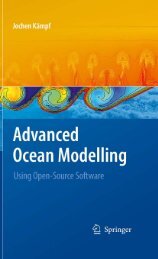- Page 2:
Ocean Modelling for Beginners
- Page 6:
Assoc. Prof. Jochen KämpfSchool of
- Page 10:
viPrefaceAccess to a standard compu
- Page 16:
Contentsix3.7.3 Apparent Forces . .
- Page 20:
Contentsxi4.2.3 The Shallow-Water M
- Page 24:
Contentsxiii5.9 Exercise 13: Inclus
- Page 28:
Contentsxv6.13.3 Results...........
- Page 32:
2 1 RequirementsMicrosoft Windows O
- Page 36:
Chapter 2MotivationAbstract This ch
- Page 40:
2.1 The Decay Problem 7Fig. 2.1 Evo
- Page 44:
2.2 First Steps with Finite Differe
- Page 48:
2.2 First Steps with Finite Differe
- Page 52:
2.3 Exercise 1: The Decay Problem 1
- Page 56:
2.4 Detection and Elimination of Er
- Page 60:
Chapter 3Basics of Geophysical Flui
- Page 64:
3.3 Location and Velocity 19Fig. 3.
- Page 68:
3.5 Visualisation of a Wave Using S
- Page 72:
3.5 Visualisation of a Wave Using S
- Page 76:
3.6 Exercise 2: Wave Interference 2
- Page 80:
3.7 Forces 273.7 Forces3.7.1 What F
- Page 84:
3.7 Forces 293.7.6 Interpretation o
- Page 88:
3.8 Fundamental Conservation Princi
- Page 92:
3.8 Fundamental Conservation Princi
- Page 96:
3.9 Gravity and the Buoyancy Force
- Page 100:
3.10 Exercise 3: Oscillations of a
- Page 104:
3.10 Exercise 3: Oscillations of a
- Page 108:
3.11 The Pressure-Gradient Force 41
- Page 112:
3.12 The Coriolis Force 43where red
- Page 116:
3.12 The Coriolis Force 45operates
- Page 120:
3.12 The Coriolis Force 47where the
- Page 124:
3.12 The Coriolis Force 49where n i
- Page 128:
3.13 The Coriolis Force on Earth 51
- Page 132:
3.14 Exercise 4: The Coriolis Force
- Page 136:
3.14 Exercise 4: The Coriolis Force
- Page 140:
3.15 Turbulence 57(10 cm/s, 0 cm/s)
- Page 144:
3.15 Turbulence 593.15.5 Turbulence
- Page 148:
3.17 Scaling 613.16.2 Boundary Cond
- Page 152:
3.17 Scaling 63where T i is the ine
- Page 156:
66 4 Long Waves in a ChannelOn the
- Page 160:
68 4 Long Waves in a ChannelThe tru
- Page 164:
70 4 Long Waves in a ChannelIt can
- Page 168:
72 4 Long Waves in a ChannelFig. 4.
- Page 172:
74 4 Long Waves in a ChannelZero-gr
- Page 176:
76 4 Long Waves in a ChannelFig. 4.
- Page 180:
78 4 Long Waves in a ChannelFig. 4.
- Page 184:
80 4 Long Waves in a Channel3. True
- Page 188:
82 4 Long Waves in a Channelplace w
- Page 192:
84 4 Long Waves in a Channelwhere h
- Page 196:
86 4 Long Waves in a ChannelFig. 4.
- Page 200:
88 4 Long Waves in a Channel4.6.8 C
- Page 204:
Chapter 52D Shallow-Water Modelling
- Page 208:
5.1 Long Waves in a Shallow Lake 93
- Page 212:
5.3 Exercise9:WaveRefraction 95Fig.
- Page 216:
5.3 Exercise9:WaveRefraction 97Fig.
- Page 220:
5.4 The Wind-Forced Shallow-Water M
- Page 224:
5.5 Exercise 10: Wind-Driven Flow i
- Page 228:
5.5 Exercise 10: Wind-Driven Flow i
- Page 232:
5.6 Movement of Tracers 105In all s
- Page 236:
5.7 Exercise 11: Eulerian Advection
- Page 240:
5.8 Exercise 12: Trajectories 1095.
- Page 244:
5.9 Exercise 13: Inclusion of Nonli
- Page 248:
5.10 Exercise 14: Island Wakes 1135
- Page 252:
5.10 Exercise 14: Island Wakes 1155
- Page 256:
5.10 Exercise 14: Island Wakes 1175
- Page 260:
Chapter 6Rotational EffectsAbstract
- Page 264:
6.3 Exercise 15: Coastal Kelvin Wav
- Page 268:
6.4 Geostrophic Flow 123Sect. 3.17)
- Page 272:
6.4 Geostrophic Flow 125Fig. 6.2 Ex
- Page 276:
6.4 Geostrophic Flow 127In a multi-
- Page 280:
6.5 Exercise 16: Topographic Steeri
- Page 284:
6.5 Exercise 16: Topographic Steeri
- Page 288:
6.6 Instability of Lateral Shear Fl
- Page 292:
6.7 Exercise 17: Barotropic Instabi
- Page 296:
6.8 The Wind-Driven Circulation of
- Page 300: 6.8 The Wind-Driven Circulation of
- Page 304: 6.8 The Wind-Driven Circulation of
- Page 308: 6.8 The Wind-Driven Circulation of
- Page 312: 6.9 Exercise 18: The Wind-Driven Ci
- Page 316: 6.9 Exercise 18: The Wind-Driven Ci
- Page 320: 6.11 The Reduced-Gravity Concept 14
- Page 324: 6.12 Geostrophic Adjustment of a De
- Page 328: 6.12 Geostrophic Adjustment of a De
- Page 332: 6.13 Exercise 20: Geostrophic Adjus
- Page 336: 6.14 Baroclinic Instability 157Fig.
- Page 340: 6.15 Exercise 21: Frontal Instabili
- Page 344: 6.15 Exercise 21: Frontal Instabili
- Page 348: 6.17 Exercise 22: Reduced-Gravity P
- Page 354: 166 6 Rotational EffectsFig. 6.32 S
- Page 358: BibliographyArakawa, A., and Lamb,
- Page 362: List of Exercises• Exercise 1: Th
- Page 366: 174 IndexFFinite differencesexplici
















